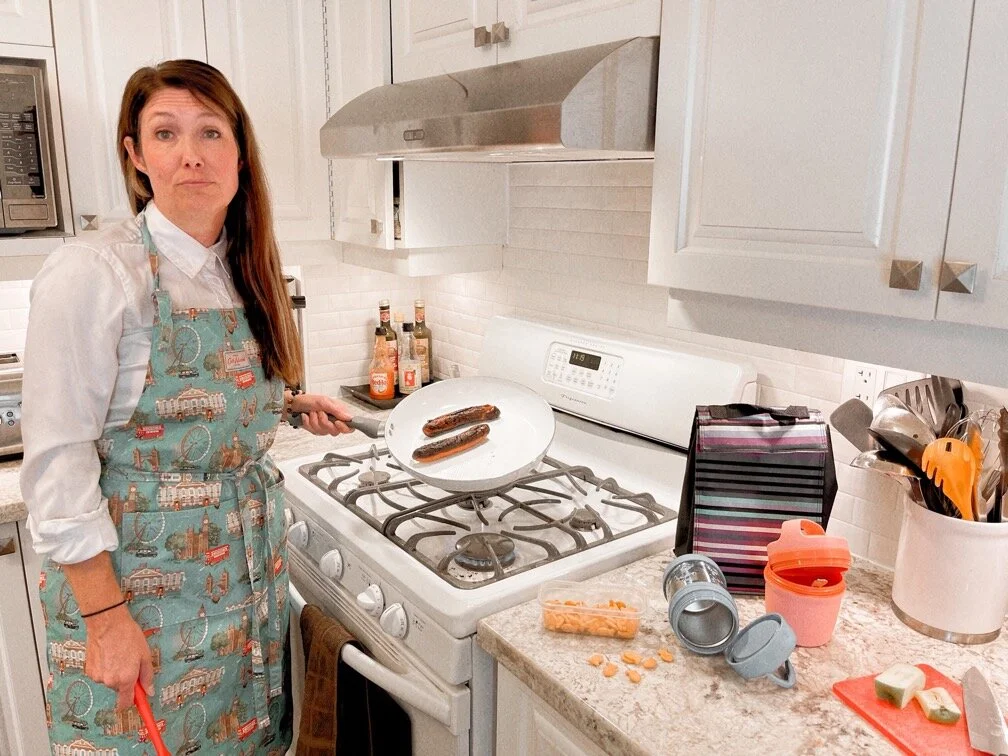Your a millenial mom and it's 5:30 p.m., now what?
/Real photo of sarah kate’s kitchen every MORNING
If you have to hype yourself up for your second job that starts every day when the school bell rings, you’ll be familiar with the stress and chaotic schedule of parenting young kids and tweens. After we clock out of one job, we’re on the clock for our second and third jobs as chauffeurs, chefs, dog trainers, teachers, coaches and spiritual guides.
You may feel like you JUST NEED ONE GLASS OF WINE to get you through everything. We hear you but girl, don’t do it….
Ironically, that one glass of wine every night could actually be that culprit behind your stress and anxiety. What we know from recent studies is alcohol doesn’t help relax us the way we think it does, rather, it increases cortisol and can lead to drastic drops in dopamine making you feel worse.
In a recent Huberman Labs podcast, neuroscientist Andrew Huberman explains that if you drink one glass of wine a night regularly, it’s been shown to keep anxiety levels higher than normal even when you’re not drinking.
Reducing those glasses of wine could be the first step to feeling less stress and coping better, but what are you going to do when that urge hits to uncork something white and chilled?
It really starts with rethinking your habits, and building new ones, within your own framework. Building new habits has to be something you can easily implement - and be practically as easy as opening a bottle of wine.
Five strategies to incorporate mindful drinking into your busy evening routine:
Phone a friend (not an ex) while you’re chopping veggies - believe it or not, the simple act of connecting with a friend even over the phone can boost dopamine and release tension, hopefully cancelling out the desire to pour a glass of wine
Open a window (NOT the fridge) and take deep mindful breaths for a few minutes to clear your head - in fact, if you can just sneak out into the backyard for a minute, try a power pose for a few minutes and do some yoga breathing; this helps to reset your adrenaline response to stimulus in the house and can be calming.
Put on some LOUD music - we’ve rebooted Rage Against The Machine and religiously wish we were back in a mosh pit for a few minutes. We’ve also cranked up Getting Jiggy With It because there is nothing like a Will Smith bop to boost the mood.
Check on your stock options - Seriously. If time allows, step away, and take 10-15 minutes and check-in on something that you need to concentrate on. The urge will pass and you will feel a little more in control. This could be financial, or just renewing your library books online, anything that you need some light concentration for.
Alcohol-free drinks are optional - there are hundreds of options out there for you now. If you like wine, check out our non-alcoholic wine reviews. If you like mocktails, there are lots of canned options that are low-in-sugar and easy to crack open. Daytrip is a great CBD option, if you’re open to gardening, and it’s really low sugar and doesn’t taste ‘herbal’ if you know what I mean.
If you don’t have a friend to call, there are lots of “soberish” or “trying dry” online communities on Instagram - it doesn’t mean you have to be sober, but finding someone to reach out to when you’re feeling like a glass of wine doesn’t have to be so serious. It can be nice to just have a connection with someone if you need it. Here are a few to start with:
Join Soberish
1000 Hours Dry
Sober Mom Squad
If all else fails, have the glass of wine, but monitor how you’re feeling physically and try and find some time to look inwards and assess what went wrong.
One thing to remember is that it’s not a test, rather it’s a journey and you just need a new set of tools for the road!
Note: If you’re really struggling with alcohol dependence, want to quit drinking, and/or experiencing severe withdrawal symptoms, please get professional help. Reaching out for help does not mean you’re an alcoholic. You can call a support line for information and a referral to treatment providers or get virtual assistance in lots of ways. In the U.S. the SAMHSA National Helpline is 800–662–HELP. In Canada, please visit this website for regional and local resources.




